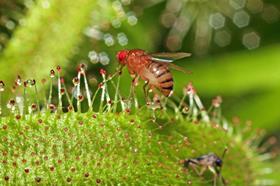
Scientists in Sweden and the US believe they have discovered the origins of the fruit fly and how it found its way into our fruit bowls.
Prior to the new report, no one knew howfruit flies, or Drosophila melanogaster, became our inivited lodgers, despite decades of research.
But now a Swedish-American research team from Lund University andthe University of Wisconsin-Madisonbelieves it has uncovered the origins of one of the most studied organisms in science.
Their study, which was published on 6 December in the journal Current Biology, suggests that fruit flies first moved into humans’ homes around 10,000 year ago when they flew into the caves of the indigenous San people in southern Africa.
The researchers say the flies would have been attracted to the smell of marula fruit, which was collected by the San and stored in their caves.In one cave, archaeologists found more than 24 million walnut-sized marula pips.
The yellow stonefruit was a staple in southern Africa at that times, as well as being the fruit that wild flies apparently evolved to depend on in nearby forests.
After several years of searching, it was in the forests of what is now Zambia and Zimbabwe that the researchers succeeded in capturing the flies – the first time this had ever been achieved in the wild.
Traps close to the African stonefruit marula were quickly filled with flies, while traps at other locations remained empty or only attracted a few flies.
The researchers already knew that overripe, rotten, citrus fruits are fruit flies’ favourite in the fruit bowl so they tested what the flies preferred in the wild: marula or citrus.
The answer was marula, and they got the same results when testing fruit flies in other parts of the world, flies that had never previously been anywhere near marula.
“At home in the kitchen the flies feast on whatever is starting to rot in the fruit bowl, even though they like citrus fruits best. In the wild they are far more picky, they prefer marula fruit,” said Marcus Stensmyr.
“They are drawn to particular aromatic substances from marula that activate receptors on the antennae. When these are activated, it’s a sign that it’s a good place to lay eggs.”
The researchers’ conclusion is that the San people’s love of marula fruit explains why the fruit flies moved in with people long ago. Over time the flies adjusted to living inside and became increasingly tolerant to ethanol in rotten fruit.
“The fly has developed into a generalist that eats and breeds in all sorts of fruit. But originally it was a real specialist that only lived where there was marula fruit”, said Stensmyr.



